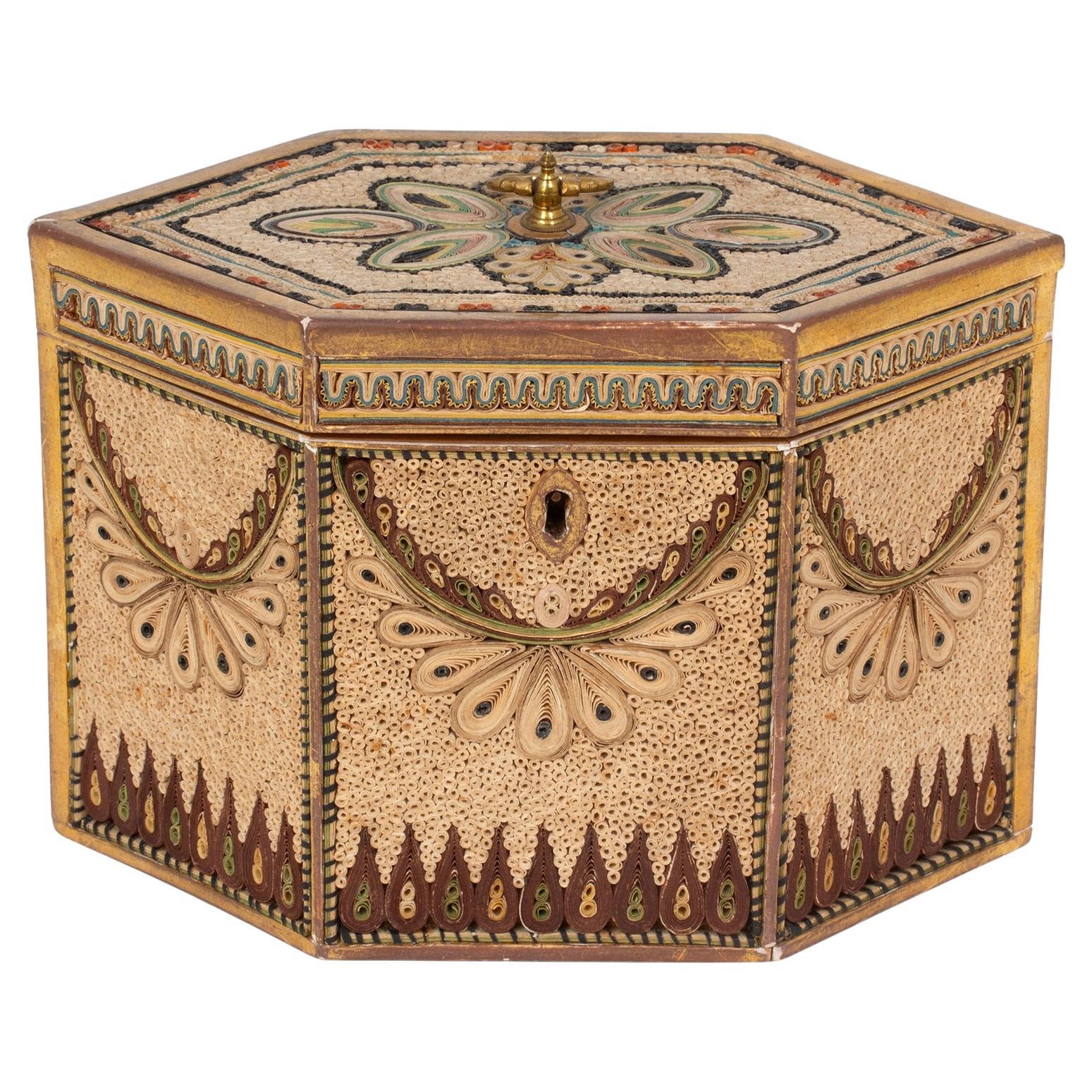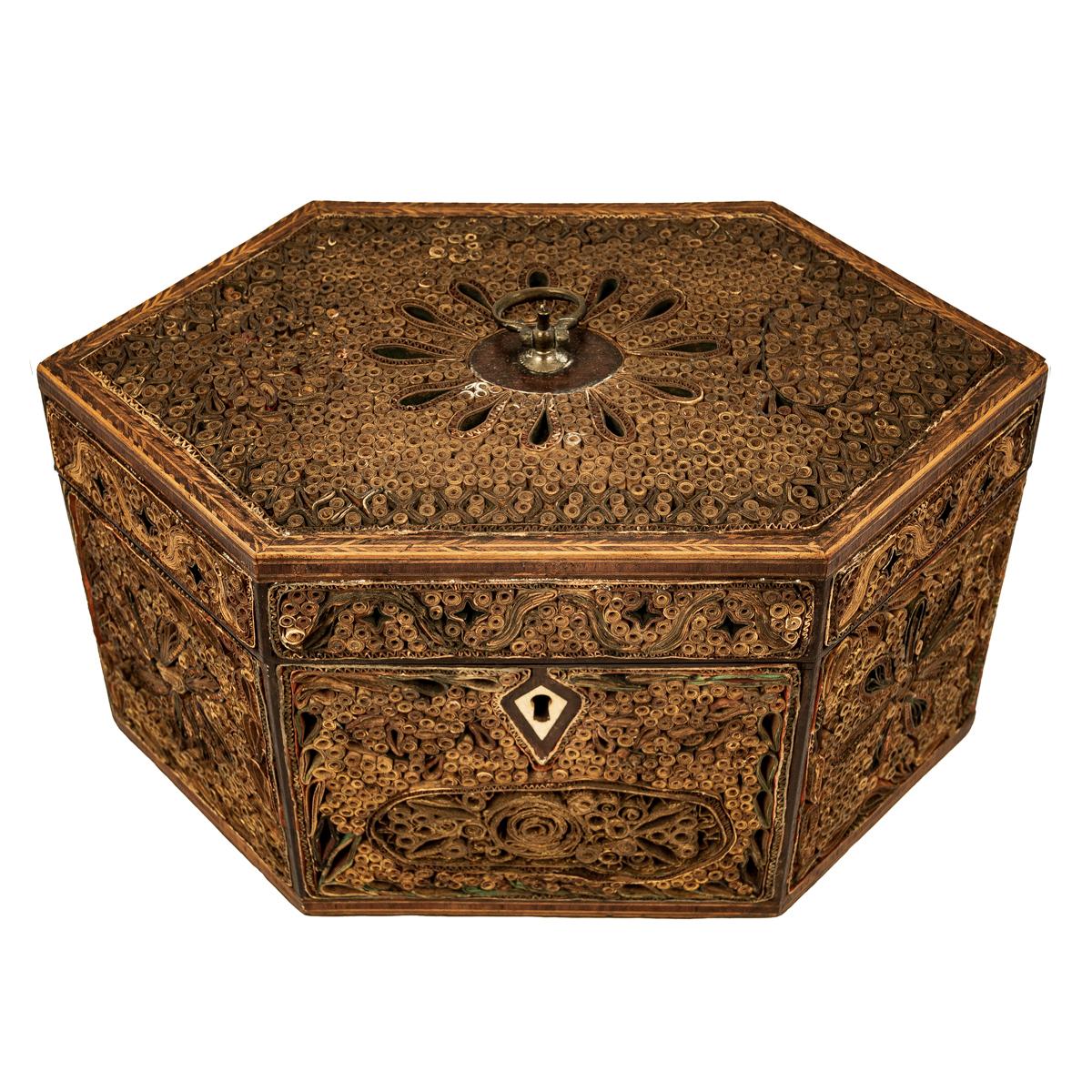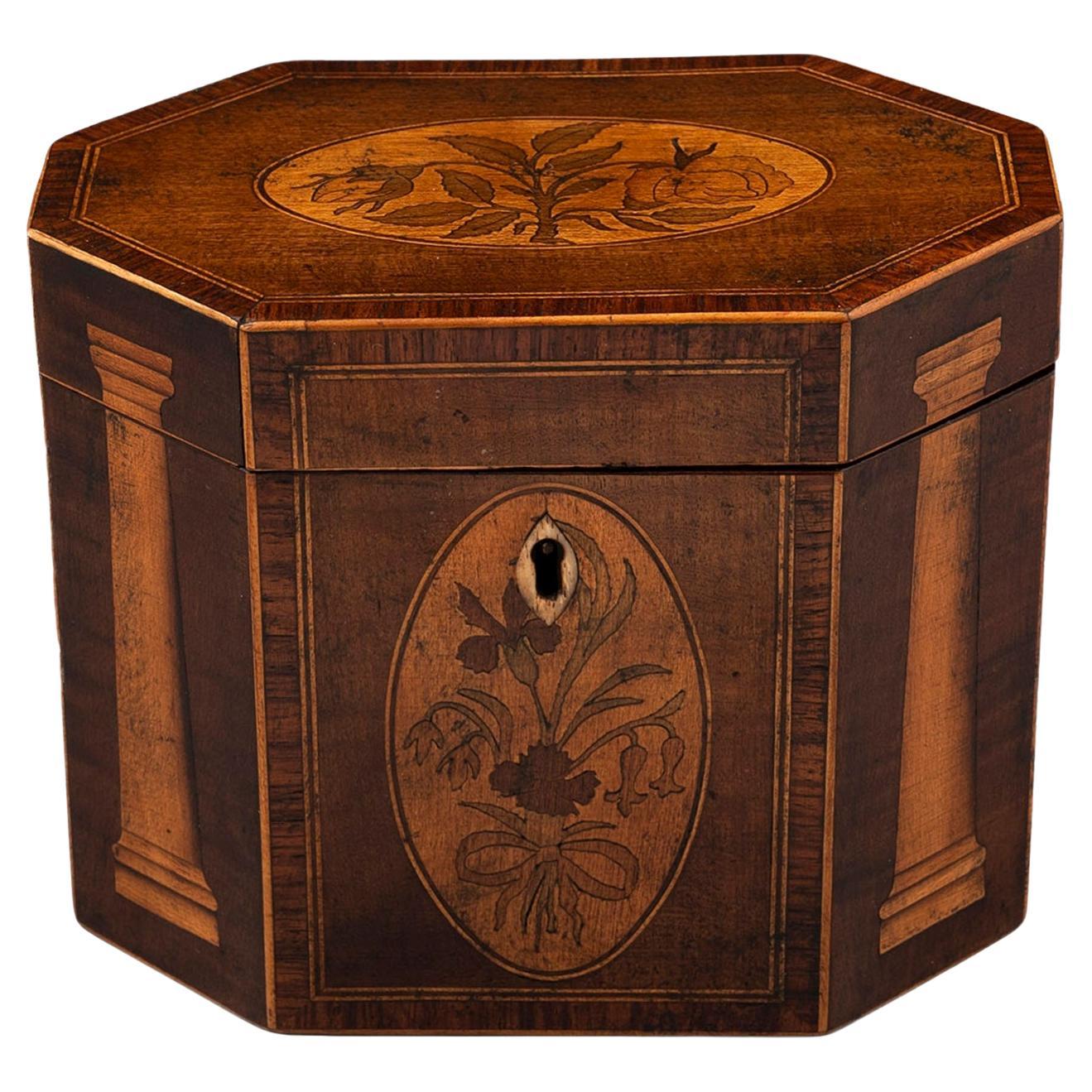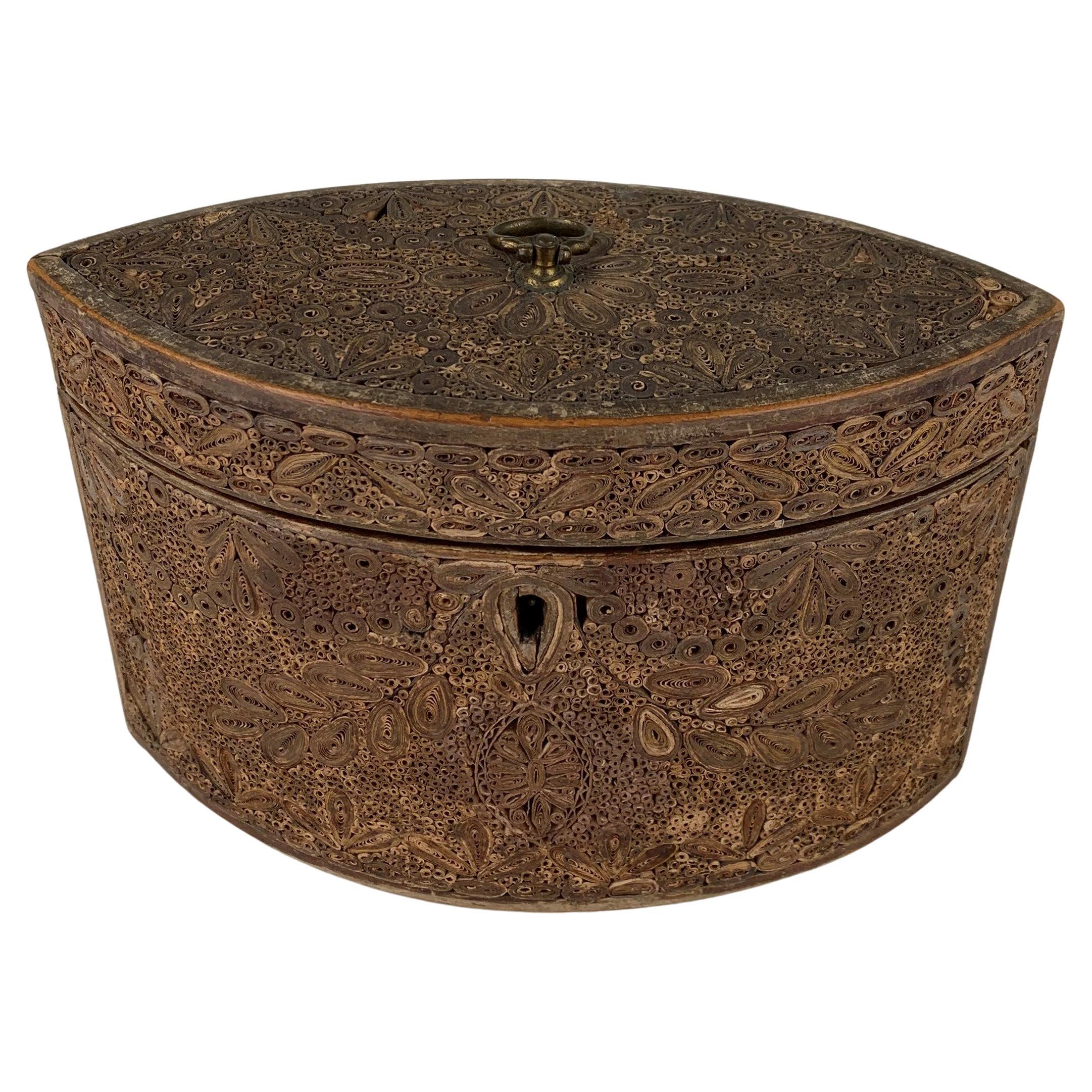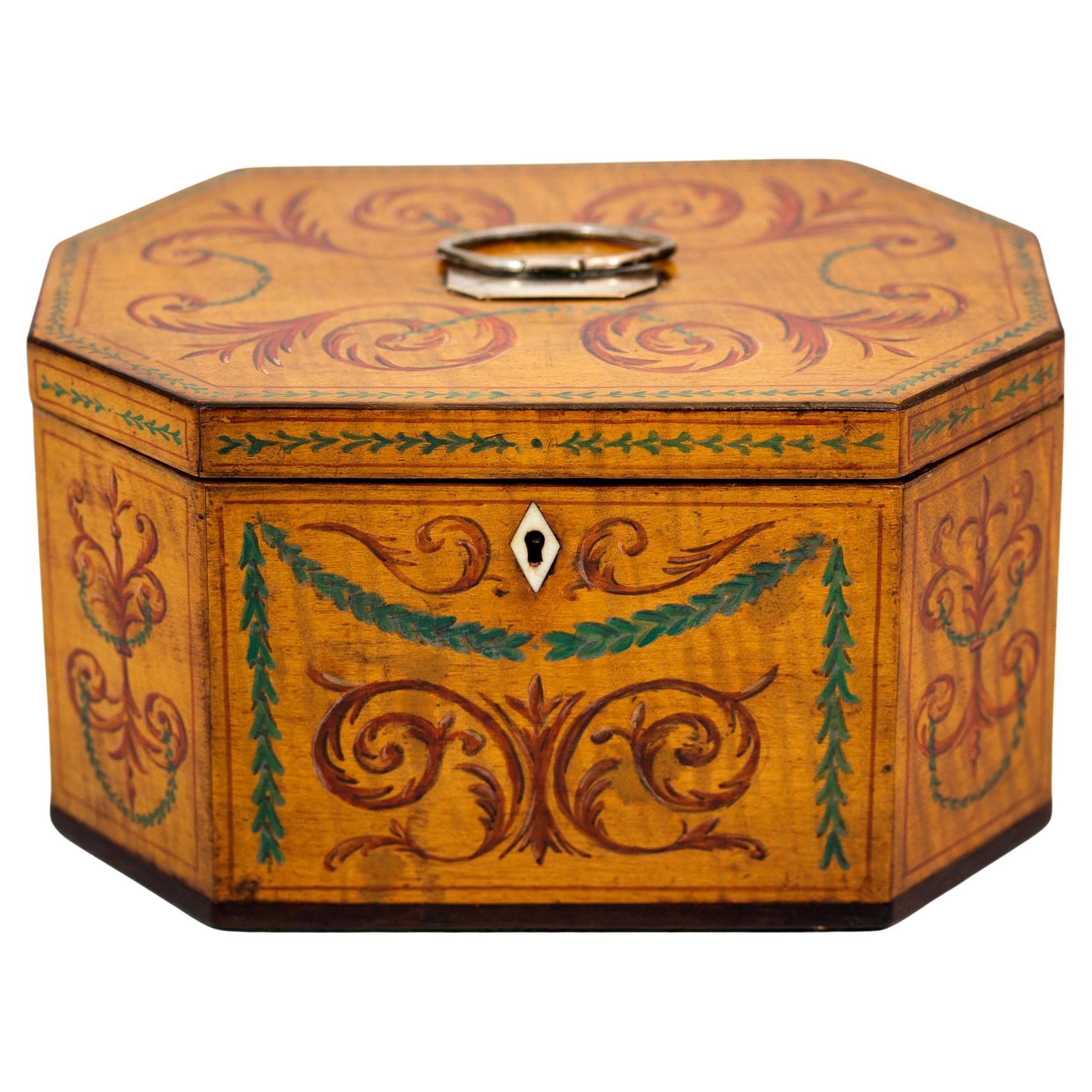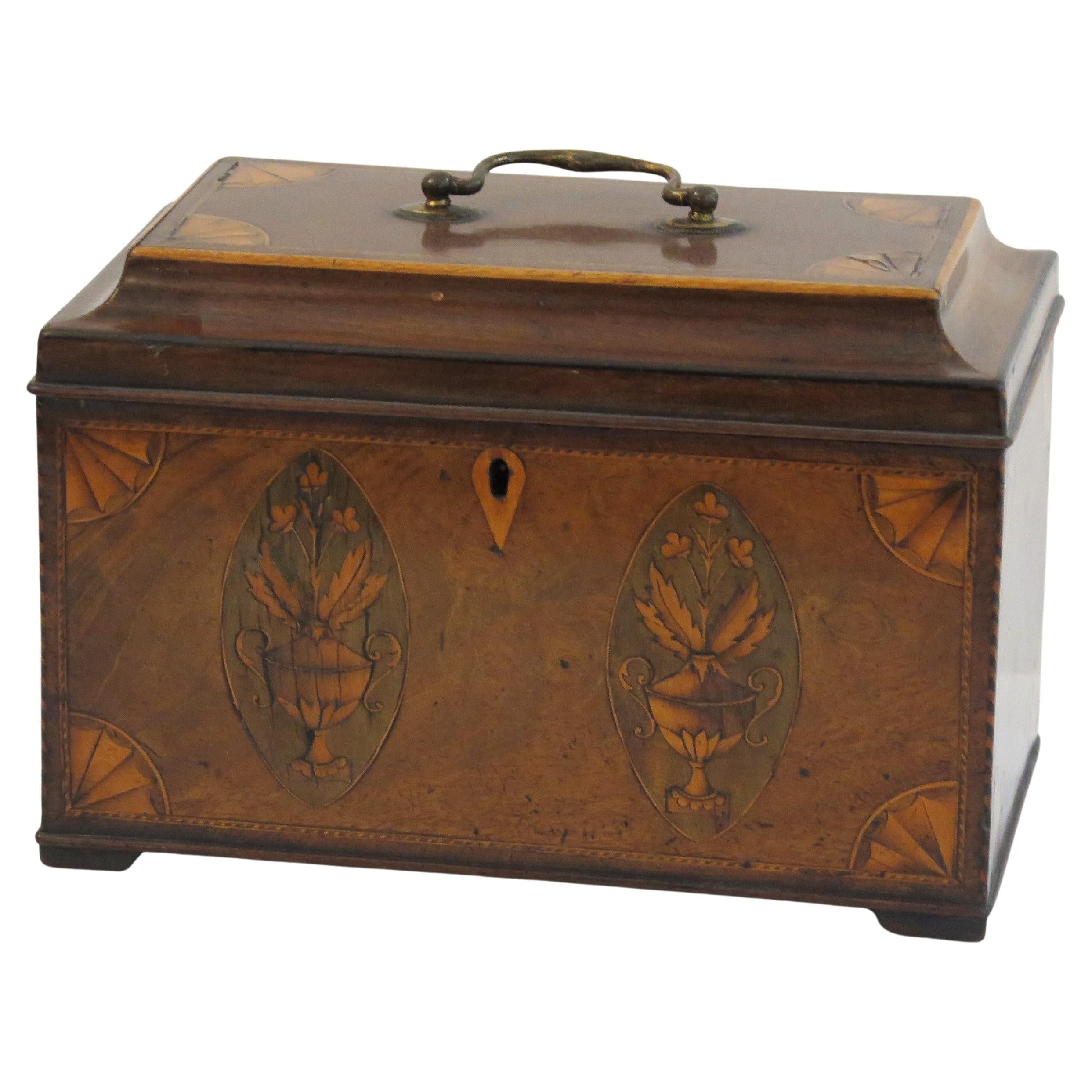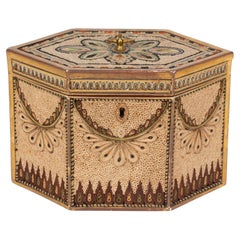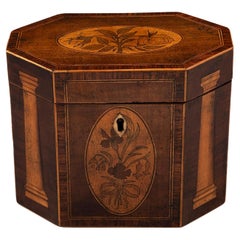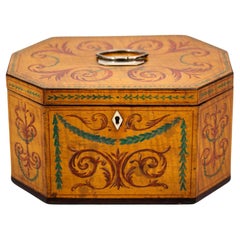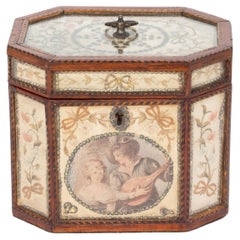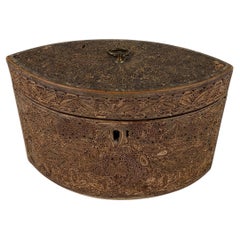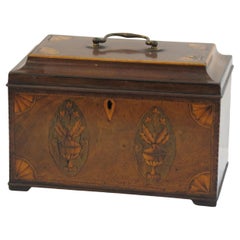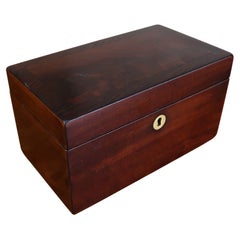Items Similar to Antique Georgian Paper Scroll Tea Caddy
Want more images or videos?
Request additional images or videos from the seller
1 of 17
Antique Georgian Paper Scroll Tea Caddy
$10,155.89
£7,600
€8,816.26
CA$14,325.39
A$15,735.81
CHF 8,223.63
MX$187,662.54
NOK 104,133.40
SEK 97,009.05
DKK 65,879.22
About the Item
Framed In Boxwood
From our Tea Caddy collection, we are delighted to offer this exceptional Georgian Paper Scroll Tea Caddy. The Tea Caddy of elongated hexagonal shape framed in boxwood with alternating stringing of Boxwood and Ebony finished with framed ebony glazed panels housing the fine paper scrollwork decoration. The front of the Tea Caddy features a central scene with floral decoration between two panels featuring coloured silk classical scenes. The rear of the tea caddy features a further vibrant blossoming flower panel and two panels with wheat ears stemming from a bow. Across the top of each panel is a smaller window with similar scenes and a central scene to the front with the letters DR. The top of the Tea Caddy is decorated with a large paper scroll panel protected by further glazing and surmounted with a small loop carry handle. The inside of the Tea Caddy is lined in pink paper with two floating lids surmounted by turned handles. The Tea Caddy dates to the late 18th century Georgian period during the reign of George III circa 1790.
The Tea Caddy comes complete with a working lock and tasselled key.
Boxwood “Buxus sempervirens” can be found in Europe, Northwest Africa and Southwest Asia. It is a light cream that turns darker to brown when exposed to light. The trees are very small meaning it is suited to smaller projects like edging or inlay instead of veneers.
Ebony is often almost completely black with very little visible grain often with a subtle red/purple hue. This wood is very expensive due to the slow-growing trees which can often be gnarly affecting the yield of straight workable wood. Most ebonies are very dense making work with hand tools very difficult and can quickly clunt cutting tools. This density however offers an excellent finish on turned items.
Paper Scrollwork (Quilling) is the art of rolling, shaping, and glueing paper that results in creating a unified, decorative design. The name quilling is thought to come from the origin of the art when birds’ feathers or quills were used to coil the strips of paper around.
- Dimensions:Height: 5.12 in (13 cm)Width: 7.29 in (18.5 cm)Depth: 4.14 in (10.5 cm)
- Style:George II (Of the Period)
- Materials and Techniques:
- Place of Origin:
- Period:
- Date of Manufacture:Circa 1790
- Condition:
- Seller Location:Northampton, GB
- Reference Number:Seller: 501339-MAXC1stDibs: LU8027241802342
About the Seller
No Reviews Yet
Vetted Professional Seller
Every seller passes strict standards for authenticity and reliability
Established in 1998
1stDibs seller since 2023
34 sales on 1stDibs
Typical response time: <1 hour
- ShippingRetrieving quote...Shipping from: Northampton, United Kingdom
- Return Policy
More From This Seller
View AllGeorgian Antique Original English Paper Scroll Tea Caddy
Located in Northampton, GB
Free Worldwide Shipping
George III Circa 1780
From our Tea Caddy collection, we are delighted to offer this Antique Paper Scroll Tea Caddy. The Tea Caddy of elongated hexagonal for...
Category
Antique Late 18th Century British George III Tea Caddies
Materials
Wood, Paper
Antique English George III Inlaid Tea Caddy
Located in Northampton, GB
From our Tea Caddy collection, we are pleased to offer this Georgian octagonal Inlaid Tea Caddy. The Tea Caddy of octagonal form veneered in Harewood with inlaid twin Tuscan Columns ...
Category
Antique Late 18th Century English Georgian Tea Caddies
Materials
Boxwood
Georgian Original Painted Sycamore Tea Caddy
Located in Northampton, GB
George III Circa 1785
From our Tea Caddy collection, we are delighted to offer this Rare Original Hand-Painted Sycamore Tea Caddy. The Tea Caddy of Octagonal form veneered in Sycamo...
Category
Antique Late 18th Century George III Tea Caddies
Materials
Sycamore
Antique English Georgian Glazed Silk Embroidered Tea Caddy
Located in Northampton, GB
Octagonal Shape with Glazed Panels
From our Tea Caddy collection, we are delighted to bring to market this wonderful example Georgian Glazed Silk Embroidered Tea Caddy. The Tea Cad...
Category
Antique Late 18th Century English George III Tea Caddies
Materials
Glass, Wood, Boxwood, Satinwood
English Antique Georgian Henry Clay Papier Mache Tea Caddy
By Henry Clay
Located in Northampton, GB
Featuring Countryside Scenes
From our Tea Caddy collection, we are delighted to introduce to the market this Papier Mache Tea Caddy by Henry Clay. The Henry Clay Tea Caddy of oval ...
Category
Antique Early 1800s English George III Tea Caddies
Materials
Paper
Georgian Harewood Tea Caddy
Located in Northampton, GB
With Tuscan Columns & Fan Inlay.
From our Tea Caddy collection, we are pleased to offer this Georgian Harewood Tea Caddy. The Tea Caddy of octagonal shape with a Harewood veneer ext...
Category
Antique Late 18th Century English George III Tea Caddies
Materials
Boxwood, Harewood
You May Also Like
Antique 18th Century Georgian Mahoghany Paper Scroll Work Tea Caddy Box 1780
Located in Portland, OR
A good antique Georgian scrollwork tea caddy, circa 1780.
The caddy of hexagonal shape, the front, back & cover with overall decoration of paper s...
Category
Antique 1780s English George III Tea Caddies
Materials
Ivory, Mahogany, Satinwood, Paper
Fine Rolled Paper Tea Caddy
Located in Folkestone, GB
A fine quality rolled/scrolled paperwork single compartmemt tea caddy in good originl condition with minor losses. Decorated all-over with applied scrolls of gilt edged and coloured ...
Category
Antique Late 18th Century English Georgian Tea Caddies
Materials
Paper
$1,122 Sale Price
20% Off
Georgian Sheraton Period Tea Caddy finely Inlaid, English circa 1780
By Thomas Sheraton
Located in Lincoln, Lincolnshire
A very beautiful, fine quality, inlaid Tea Caddy from the English Georgian, Sheraton Period, Circa 1780.
The Tea Caddy is all handmade with very fine quality features;
* Beautifully...
Category
Antique Late 18th Century English George III Tea Caddies
Materials
Boxwood, Satinwood, Sycamore, Walnut, Hardwood
Small Antique Georgian Tea Caddy With Crossbanding. English C.1800
Located in St Annes, Lancashire
A lovely Georgian tea caddy.
Two compartments internally with lids
Tropical hardwood with cross banding to the top
Fabulous grain particularly on the top
Free UK shipping
Category
Antique Early 1800s English Georgian Tea Caddies
Materials
Wood
$262 Sale Price
25% Off
Georgian Octagonal Inlaid Tea Caddy
Located in Greenwich, CT
Fine George III octagonal tea caddy inlaid with various woods on a harewood ground, the central panels veneered with coucous wood and banded by holly stringing around a kingwood band, vines and berried...
Category
Antique 1780s English George III Tea Caddies
Materials
Ebony, Kingwood, Harewood, Holly, Burl
19th Century English Penwork Tea Caddy
Located in Atlanta, GA
19th Century English Penwork Tea Caddy
Category
Antique 19th Century English Tea Caddies
Materials
Wood
More Ways To Browse
Antique Scroll
Quilling Art
African Art Wood Carved Panel
Antique Cutting Tools
Paper Quilling
Paper Scroll Tea Caddy
Tortoiseshell Tea Caddies
Black Lacquer Tea Caddy
Georgian Mahogany Tea Caddy
Antique Chinese Lacquer Tea Caddy Tea Caddies
Antique Tea Container
Oval Tea Caddy
Georgian Satinwood Tea Caddies
Paper Quilling
Tortoise Shell And Ivory Box
Tunbridge Tea Caddy
Blue And White Tea Caddy
Dutch Tea Caddy
